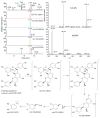Potential Valorization of Edible Nuts By-Products: Exploring the Immune-Modulatory and Antioxidants Effects of Selected Nut Shells Extracts in Relation to Their Metabolic Profiles
- PMID: 35326112
- PMCID: PMC8944461
- DOI: 10.3390/antiox11030462
Potential Valorization of Edible Nuts By-Products: Exploring the Immune-Modulatory and Antioxidants Effects of Selected Nut Shells Extracts in Relation to Their Metabolic Profiles
Abstract
The immune system is a potent army that defends our body against various infections and diseases through innate and adaptive immunity. Herbal medicine is one of the essential sources for enhancing immunity because of affordability, availability, minor side effects, and consumers' preferences. Hazelnuts, walnuts, almonds, and peanuts are among the most widespread edible nuts that are rich in phenolics, fats, fibers, vitamins, proteins, and minerals. The potential of nut shells in phytoremediation has attracted increasing attention as a sustainable solution for waste recycling. Here, we determined the in vitro immune-modulatory activity as well as the metabolite profile of the four nut shell extracts. The addition of the extracts to LPS-stimulated macrophages, especially peanut and walnut shells, has downregulated the gene expression of AP-1, TNF-α, IL-8, iNOS, and COX-2 expression levels. Significant antioxidant capabilities and immune-modulatory effects have been traced for peanut shells. UPLC-MS metabolic profiling of the four nut shell extracts allowed the detection of a relatively high level of phenolic compounds in peanut shells. Intriguingly, a significant correlation between the antioxidant capacity and the total phenolic content was found, indicating the contribution of the phenolic compounds to the antioxidant properties and hence the immune-modulatory activity. Furthermore, molecular docking and structure-activity relationship (SAR) studies revealed kaempferol rutinoside and proanthocyanidin A5' as potential iNOS inhibitors.
Keywords: SAR; by-products; immune-modulatory; metabolomics; molecular docking; nuts; shells.
Conflict of interest statement
The authors declare no conflict of interest.
Figures








Similar articles
-
Recovery of Lignins with Potent Antioxidant Properties from Shells of Edible Nuts by a Green Ball Milling/Deep Eutectic Solvent (DES)-Based Protocol.Antioxidants (Basel). 2022 Sep 21;11(10):1860. doi: 10.3390/antiox11101860. Antioxidants (Basel). 2022. PMID: 36290583 Free PMC article.
-
Sapucaia nut (Lecythis pisonis Cambess) and its by-products: A promising and underutilized source of bioactive compounds. Part II: Phenolic compounds profile.Food Res Int. 2018 Oct;112:434-442. doi: 10.1016/j.foodres.2018.06.050. Epub 2018 Jun 21. Food Res Int. 2018. PMID: 30131155
-
Tolerance of peanuts and tree nuts in Spanish children with exclusive sensitization to lipid transfer proteins.Pediatr Allergy Immunol. 2024 Jul;35(7):e14204. doi: 10.1111/pai.14204. Pediatr Allergy Immunol. 2024. PMID: 39016336
-
Edible Nuts for Memory.Curr Pharm Des. 2020;26(37):4712-4720. doi: 10.2174/1381612826666200806095649. Curr Pharm Des. 2020. PMID: 32767923 Review.
-
Association of Total Nut, Tree Nut, Peanut, and Peanut Butter Consumption with Cancer Incidence and Mortality: A Comprehensive Systematic Review and Dose-Response Meta-Analysis of Observational Studies.Adv Nutr. 2021 Jun 1;12(3):793-808. doi: 10.1093/advances/nmaa152. Adv Nutr. 2021. PMID: 33307550 Free PMC article.
Cited by
-
Biological evaluation, docking studies, and in silico ADME prediction of some pyrimidine and pyridine derivatives as potential EGFRWT and EGFRT790M inhibitors.J Enzyme Inhib Med Chem. 2023 Dec;38(1):176-191. doi: 10.1080/14756366.2022.2135512. J Enzyme Inhib Med Chem. 2023. PMID: 36317648 Free PMC article.
-
Cytotoxic and proapoptotic effects of alizarin in mice with Ehrlich solid tumor: novel insights into ERα-mediated MDM2/p-Rb/E2F1 signaling pathway.Naunyn Schmiedebergs Arch Pharmacol. 2025 Jun 28. doi: 10.1007/s00210-025-04196-7. Online ahead of print. Naunyn Schmiedebergs Arch Pharmacol. 2025. PMID: 40580306
-
Elucidation of the Hemostatic and Anti-Inflammatory Effects of Walnut Shell Ethanol Extract by Network Pharmacology and Experimental Verification.Food Sci Nutr. 2025 Aug 5;13(8):e70726. doi: 10.1002/fsn3.70726. eCollection 2025 Aug. Food Sci Nutr. 2025. PMID: 40772022 Free PMC article.
-
Polymeric Patches Based on Chitosan/Green Clay Composites and Hazelnut Shell Extract as Bio-Sustainable Medication for Wounds.Pharmaceutics. 2023 Jul 31;15(8):2057. doi: 10.3390/pharmaceutics15082057. Pharmaceutics. 2023. PMID: 37631271 Free PMC article.
-
Antioxidant Properties of Protein-Rich Plant Foods in Gastrointestinal Digestion-Peanuts as Our Antioxidant Friend or Foe in Allergies.Antioxidants (Basel). 2023 Apr 5;12(4):886. doi: 10.3390/antiox12040886. Antioxidants (Basel). 2023. PMID: 37107261 Free PMC article. Review.
References
Grants and funding
LinkOut - more resources
Full Text Sources
Research Materials
Miscellaneous

